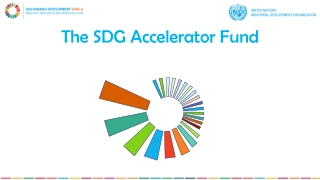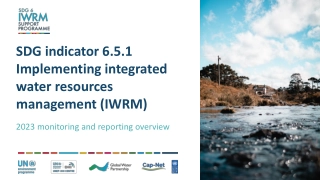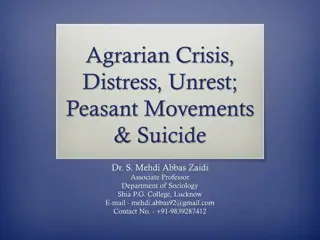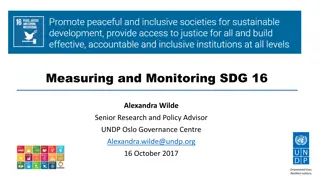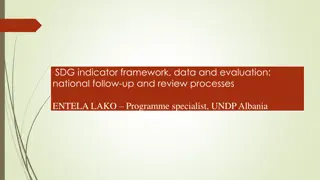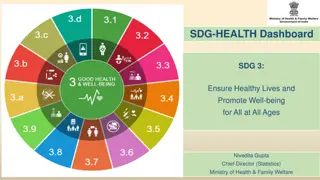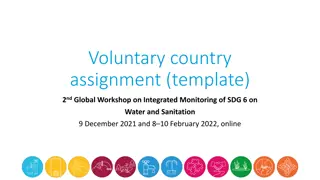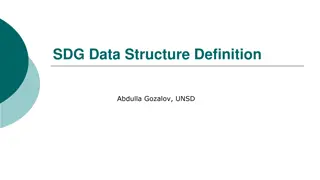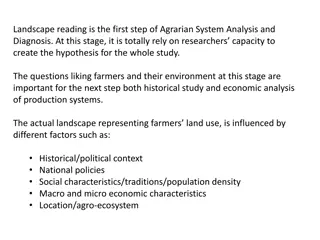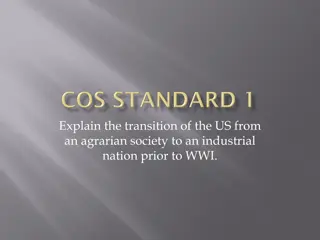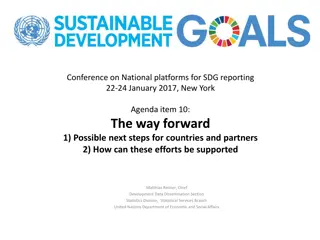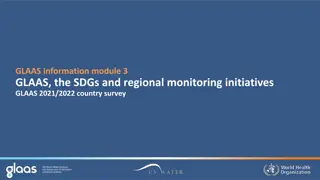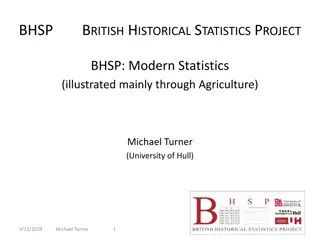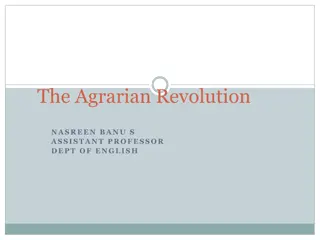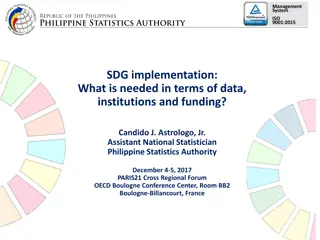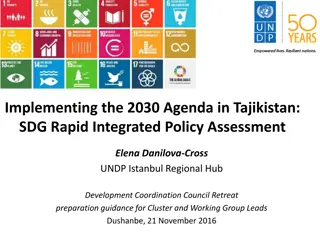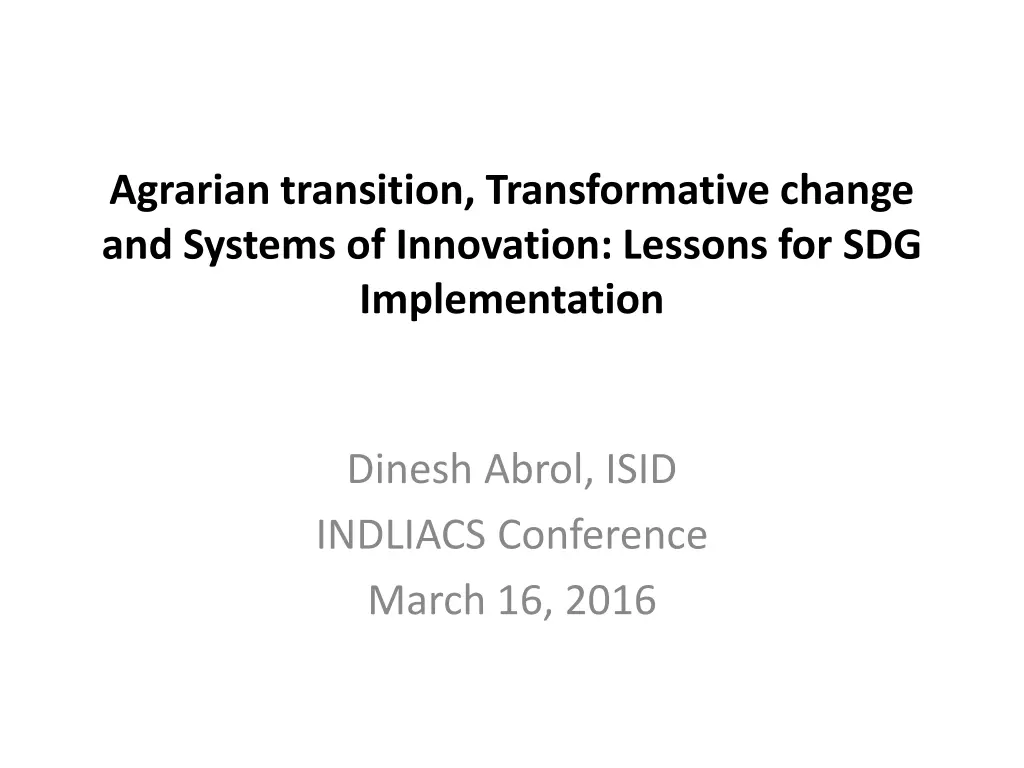
Agrarian Transition and Systems of Innovation for Sustainable Development
Explore the implications of agrarian transition and transformative change for sustainable development, focusing on innovation systems, regulation, and the political dimensions of technological advancement. Learn about the multi-level perspective, strategic niche management, and the need for social mobilization in implementing SDGs.
Download Presentation

Please find below an Image/Link to download the presentation.
The content on the website is provided AS IS for your information and personal use only. It may not be sold, licensed, or shared on other websites without obtaining consent from the author. If you encounter any issues during the download, it is possible that the publisher has removed the file from their server.
You are allowed to download the files provided on this website for personal or commercial use, subject to the condition that they are used lawfully. All files are the property of their respective owners.
The content on the website is provided AS IS for your information and personal use only. It may not be sold, licensed, or shared on other websites without obtaining consent from the author.
E N D
Presentation Transcript
Agrarian transition, Transformative change and Systems of Innovation: Lessons for SDG Implementation Dinesh Abrol, ISID INDLIACS Conference March 16, 2016
Introduction Transition Perspective approaches Multi-level perspective, Strategic Niche Management Transition management Innovation System: Failures and correctives Directionality Demand articulation Policy coordination Reflexivity Politics of transformation Contestations on LPG for opening of spaces for SD Regulation Planning Social mobilization Participation Experiment Insertion of new social carriers of innovation
Innovation Systems and Transformative Change: One view supports regulation of restrictions on technological change and the other view questions the feasibility of labour intensive methods and consequences of support for a lower growth rate of labour productivity on wellbeing Need to abandon a na ve view of technological advance as a universal achievement; difference between scientific facts and technological artifacts; interpretive flexibility evident, scientific advancement increasing the number of alternatives Socially (politically) constructed contingent combinations, demand regulation & transformation (Water, soil, agrochemicals to agro- ecology) need to work on the construction of rationality of systems, products & processes defined as codes & standards, measures of productivity (primary / secondary), co-products & byproducts obtaining, energy efficiency, emissions, non-violation of nine planetary boundaries, recyclability, reuse, sustainability (social, health and environmental), Political control of technological change are a reality, innovation systems were not constructed in a politically neutral manner
Sustainable development: What does it mean politically? Social (political) rationale of building of worker-peasant alliance for the advancement of peoples democracies demands a re- evaluation of the treatment of question of organization of productive forces, relations of production and resource use in agriculture, industry, energy, automation, environment and so on. Need to revisit the agenda for not only w r t identification of social protection related new set of immediate demands (such as income support) in the wake of the capitalist state embracing neo- liberalism but also w r t constitution of structures for the advancement of agrarian transformation industrialization of the nation. Following from the above comes the agenda of progressive mobilization on the question of technological alternatives and organizational forms in global south and autonomous
Agrarian Question Classical formulation of agrarian question considered worker- peasant alliance for : 1) breaking land concentration, 2) establishment of alternative path of peasant capitalism allowing a broad-based capitalist development and 3) formation of collective property on the basis of egalitarian land ownership to enable an advance beyond bourgeois democratic revolution towards peoples democracy and socialism. Emergence of corporate capital as a player and the state embracing neo-liberalism withdrawing from the role of supporting the peasantry and petty producers Understanding for example whether the cost for small and marginal farmers is higher now than before or not
New areas of transitional demands Environment, Energy and Resource use Degradation of eco-system functions can come from two major sources (C.H. Hanumantho Rao, 1988): first source: from deforestation and degradation of land on account of vegetative cover, resulting in low water table and loss of top soil which have a direct bearing on the productivity of soil, its vulnerability to rainfall variations, scarcities of drinking water, fodder and fuel wood causing hardships to the rural poor and Second source: from monocultures and the misapplication of yield increasing inputs like water, chemical fertilizers and pesticides, causing water logging and salinity and pollution of drinking water, loss of fish, etc. Second source of ecological degradation considered unimportant w r t the treatment of the question of productive forces, relations in production and resource use in progressive social science discourse Social rationality not problematized from environment, health, nutrition Lessons from the experience of labour resistance (labour process debate of global south)
Not Anthropocene, But Capitlocene Contradiction with big business and capitalist landlords accentuating due to consequences of mainstream pathways for maintenance and development of primary productivity and eco- system functions Discourse on the irrationality of mainstream pathways of (e.g. high external input system of agriculture- agro-chemical, GM, monocultures, RETs / fossil fuel use, diseconomies w r t automobile & logistics, ecological degradation / climate change and deskilling Question of alternatives to capitalist treatment of eco-system degradation, productive forces, relations of production & resource use following from the tendencies of cheap nature and unpaid labour is still not central or in focus Need of correctives and the question of agenda of the labour s agrarian question in temperate lands
New Transitional demands 1) resisting withdrawal of the state from the role of supporting the peasantry and petty producers, 2) struggle against primitive accumulation of capital leading to the dispossession of peasantry and ensuring that land acquisition takes place in conformity with social rationality, 3) struggle against corporate and contract farming practices 4) preventing peasantry from making a shift to socially irrational technological and organizational changes and cropping systems which endanger food security and 5) promoting the implementation of MGNREGS by forming trade unions and uniting people against the privatization of education and health.
New Areas of Transitional Demands Demands framed in respect of land relations and use, support restoration for agriculture (income support, price control, input subsidy, public procurement), debt relief, income assurance Demands focus on relief & survival which are in long run in conflict with the achievement of goals of economic, social and ecological justice Agro-ecological approaches are better placed to resolve this conflict; social carriers and eco-system for a new socio-technical regime need to be created Social movements & researchers need to debate and deliberate on alternatives to dominant perspective emerging on the technology question. 9
Agro-ecology Towards an alternate pathway Struggles emerging for the realization of ecological justice allow an alignment of peasant rationality technologically and organizational changes. Environmental problems offer an important opportunity and can help create a new track of mobilisation of peasantry, artisans and rural labour against big business and capitalist landlords. Pathways that embrace ecological agriculture friendly socio- technical systems to permit new relations in resource use, technology choices, the use and structuring of labour power and their relationship with the state. Spaces for the construction of all-in-peasant unity, unity of petty commodity producers from both farm and non-farm sectors and the leadership of working class including rural labour can be realized far more rapidly. with socially rational
Sustainability, Technology and Capital Technology in the seed, modern plant breeding & GMs deliver solutions to hunger which get rolled out at scale Seed companies, international & national agricultural research bodies, plant breeders & biotechnologists, funding organizations are still wedded to dominant perspective Increases in crop productivity at the field and crop level extrapolated as a gain of food security, system change framed in terms of investment in technology, supply chain, credit, management, etc. Skewed funding of public research, disciplines, hierarchies, priorities, IP based incentives, PPPs, corporate agriculture Crisis continues, food availability, livelihood insecurity, worsening of ecological health, public health, etc. 11
Agriculture: Experiments, Niches and Regime Natural Farming / Traditional Farming; Organic farming (input change); Agro-ecological approaches promoting Integrated and diversified farming systems Search for technological alternative at the farm level Eco-system level planning, organization of neighbourhood user communities for equitable access, socially rational resource use and recovery of commons- land, grazing areas, wetlands, forest and water sources Experiments for transformation of socio-technical regime change at the level of state policy and programme NPM, Organic Agriculture Restoration of paddy Water management Animal husbandry Forest Rights
Technological Modernization: Indian Journey Mainstream conception of technological modernization providing competition to the conceptions of residual pathways, Gains of pre & post-liberalization catch up strategy do not accrue to the poor; mainstream technological modernization had a bias; growth not upgrading local economies ; growing dependence on trickle down in neo-liberal regime (130-300 yrs) considering large scale technological systems to be superior for all activities & practicing value-neutral S&T development under the hegemony of a universal worldview of progress Outcomes of pro-poor innovation-making pathways also determined by the challenge to mainstream from the other three residual frames of socio-technical modernization Frame I (KVIC, Gandhian and Neo-Gandhian Tradition ) Frame II ( CSIR & Nehruvian Imagination) Frame III (PSM ) 5/30/2025 Dinesh Abrol 13
Non-mainstream pathways Framings Frame I (KVIC, Gandhian and Neo-Gandhian Tradition ) Upsizing / modernizing indigenous technology and individual producer to be made competitive by upgrading the local / traditional technology (Frame used by appropriate / intermediate technology movement in based on the ideas of (Schumacher Gandhian tradition; Small is beautiful), indigenous / local knowledge, local raw materials, skills & capabilities; ) which sees holism in individual producer completing the production of product without any / minimum division of labour (KVIC) Frame II ( CSIR & Nehruvian Imagination) Downsizing modern technology in order to make the technology appropriate for tiny / micro / small & medium enterprises & this frame of appropriate / economical / commercial sizing & designing approach has been used by local ingenuity innovators / mainstream in S&T to accommodate the role of MSMEs in the economy(CSIR) Frame III (PSM) Organizing the unorganized for cooperation in production, economies of scale & scope via technological upgrading of peasant-artisan economies as systems in itself for multi- sectoral network development 5/30/2025 Dinesh Abrol 14
Transformation Challenge Peasant-Artisan-Worker Relations in Multi-sectoral Economy Rudimentary networks exist for all Upgrading of peasant-artisan economy as system in itself S&T Field Groups and networks feasible for all Examples of system design which reflect the rationality (techno-economic, environmental, resource use, market development, capabilities development, political & social control) Leather & full carcass utilization Black mithy & carpentry; construction technology and materials, pottery, reed/bamboo works. Animal husbandry & dairy products Horticulture Products:- Processing & preservation Plant based health systems Aquaculture (fresh/coastal) Economic plants processing Land, water & cover including nursery & seed selection to fulfill needs of above sections (integrated) 15
Labour and Rural Industrialization: Need for a transformative strategy distributed, networked rural enterprises systemically integrated/ localized/decentralized production and distribution systems adding value to rural plant/animal/mineral resources for finished/semi-processed products local/regional markets or intermediates create rural jobs, improve rural incomes, improve rural-urban terms of trade save transport energy, reduce urbanization Antidote of neo-liberal globalization: low entropy system
Worker-Peasant Alliance, Collective Property and Group Enterprise Organizing the unorganized for cooperation in production Experiments in the construction of rural non-farm systems in fruits & vegetable processing, millets processing, oilseeds processing, pulse milling, non-edible oilseeds utilization, Socially rational mechanization, women organize for labour collectives and land leasing and green army. Kudumbshree
Understanding systemic connections Relations within sectors between operations at different levels. Relations between sectors Relationship of engineering sector primary/secondary sectors Relationship of multipurpose multi-species wood lots with secondary production. Relationship between primary & secondary production MESSAGE: Artisan based secondary production helps develop organization & scale of coverage. 18
Map 1 19
Peasant-Artisan Economy & Networked Production System B/M/S level- Units R-M collection primary processing co--products NODAL Unit Finish-processing by-products Quality control buy-back from S/V-Units Marketing further value-addition
System Design for Bullock Cart N/B/M/S Complete Bullock Carts Fabrication B/M/S Beam Repair Replacement Wheel Replacement Purchase Iron Tyre Fixing Peasant User of Cart Immediate Fixing M/S N Village near Forest Small Town Carpenter, Blacksmith @ N, or @ Large, or Region Meals 21
Horticulture/NTFP Processing India is world s largest producer of Fruits/Veg 65% by small farmers; but 25% wasted, only 3% processed System Design network of growers cluster of 15-20 vill. Nodal mother Unit + vill. satellite ops. multi-product Unit year-round ops. FPO licensed branded products local/nearby markets finished/semi-fin. for bulk buyers 10 f-t, 40-50 seasonal jobs mostly women Over 40 Units set up all over India
Red-Clay Pottery 400,000 Potters in India in near-terminal decline due to shrinking markets, rival materials, old techniques, limitations of red clay CTD Technology Package upgraded clay (1050 C) red-clay + admixtures diversified product range table-ware, tiles... new forming methods slip cast, press, jigger equipment/machines pug mill, ball mill, kiln CTD LPG Kiln Field Model Unit for 6-10 Potters satellite Units upto biscuit local incl. tourist markets Pilot Plant
System Design & Development: System of Production-Organisation of Multi-level Nodes N Level: Marketing & Technology Incubation B Level:Mini Dal Mill and One TPD Oil Units, Tertiary Processing: Sattu, Besan etc. M Level: Units for Pulse dehusking, Cattle feed & Seed production M M M S S S S S S S S Level: Drying and Storage Units
Concluding Remarks Resist through not only preventing and opposing but also by promoting alternatives for socio-ecological and socio- technical alternatives to change the relations in resource use and production Landless and rural labour need to be prioritized in the regeneration of eco-systems and egalitarian ownership of land and other resources Redefine contiguous area based worker-peasant organization for the construction of alternate pathways to bring back the question of advance towards a more democratic polity, peoples democracy and socialism Promote democratization of knowledge production in social sciences, natural and technical sciences and technology generation.

